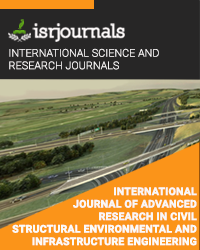electro kinetic technique -a process for soil stabilization
K.Jeevanandan,A.JEBA JESLIN
Published in International Journal of Advanced Research in Civil,Structural,Environmental and Infrastructure Engineering and Developing
ISSN: 2320-723X Impact Factor:1.7 Volume:3 Issue:1 Year: 24 February,2018 Pages:504-509

Abstract
Stabilization of soil using Electro kinetic technique is a technique which uses Direct Current to a series of Electrodes which are immersed in the soil. This Treatment is an effective treatment for the soil improvement technique to increase the shear strength of the soil, among the various stabilization techniques. This stabilization is done to improve the engineering properties of the subsoil surface while having minimum disturbance to the surface. This study aims to investigate the effects of EK treatment at voltage of 50V at different intervals. The objective of this work is to influence the pattern arrangement of electrodes on the shear strength of the soil. The various comparison tests are pattern of electrodes and spacing. The shear strength of the soil samples are found out by conducting unconfined compression tests before and after the electro kinetic stabilization of the soil. The water content of the soils was also checked before and after the test. The comparison between the pattern, voltage resistance & spacing were also Studied. The test reports indicate that the compressive and the shear strength of the soil has considerably improved after the electro kinetic stabilization treatment of the soil.
Kewords
Soft clay soil, Electrodes, Spacing, Voltage, Pattern, Electrokinetic.
Reference
#1. Afshin, A., Bujang, B. K., Hassim, M.M., Thamer, A.M.,Hanafi, M. M., and Nader, S.(2009).“Electroosmotic Phenomena in Organic Soils”, American Journal of Environmental Sciences, Vol. 5, No. 3, pp. 310-314. #2. Daniel, T., and Paravita, S.W. (2007). “Improving marine clays with electrokinetics method”, Civil Engineering Dimension, Vol. 9, No. 1,pp. 98-102. #3. Kamarudin, A., Khairul, A. K., and Taha, M. R. (2006). “Electroosmotic Flows and Electromigrations During Electrokinetic Processing of Tropical Residual Soil” Malaysian Journal of Civil Engineering,Vol. 8,No.2,pp. 74-88. #4. Kamarudin, B. A., Raihan Taha, M., and Khairul, A. K. (2011). “Electrokinetic Treatment on a Tropical Residual Soil”. #5. Dr. B.C. Punmia, Ashok Kumar Jain, Arun Kumar Jain “Soil Mechanics and Foundations” on Liquid, Plastic Limit and Unconfined Compression Test. #6. Kurochkina.G.N. Pinskii.D.L, Haynos.M, Sokolowska.Z, Tesla.I (2014). “Electrokinetic properties of soil minerals and soils modified with polyelectrolytes” Physics abstract service. #7. Mena Ramirez.E, Villasenor Camacho J, Rodrigo Rodrigo.M.A, Canizares.P (2014) “Feasibility of electrokinetic oxygen supply for soil bioremediation purposes” NCBI. #8. “Transfer of Radioactive ions in soils be electrokinetics” Office of Scientific and Technical Information(OSTI).

